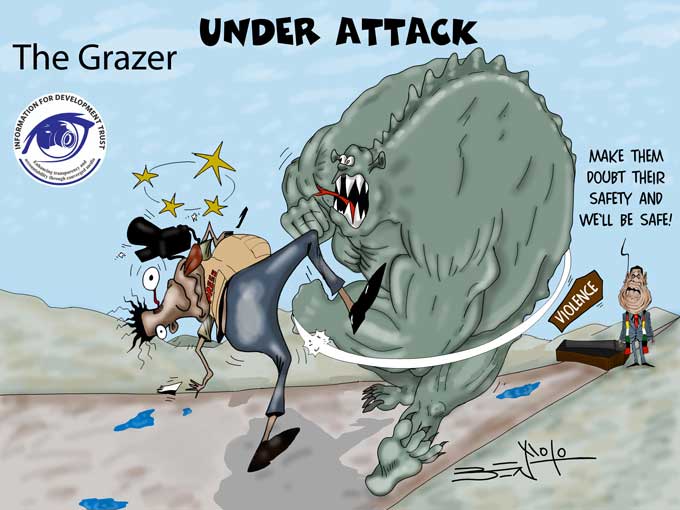
BY BHEKILIZWE BERNARD NDLOVU The visions and missions’ issue is a highly contested one the whole world over. We argued last week in this platform that there is a skill and some science needed in crafting any vision if it is to work.
If it does not inspire, there is probably something wrong with it regarding the way it was crafted. The most important standard for our sake is that of the vision being able to inspire action on the part of anyone who reads it.
This action inspiration should, in our considered and investigated opinion, lead to even a new CEO and her or his team getting up to craft their own mission which answers the question; ‘how do we achieve this vision.
This means that a vision that prescribes method is limited and stifles creativity and innovation. There is an unnecessary and retrogressive attachment to something that belongs to the world and the person who comes up with it just got inspired to be a conduit of an otherwise bigger vision that belongs to humanity.
It is important therefore to remember that all businesses come out of solving a problem and that solving that problem can happen in different ways based on the reality of that time and the brain of the people engaged with that problem.
The job of a visionary, therefore, is to fall in love with the problem and with the method because methods tend to fail the test of time and give way to newer ones that carry the load better or that tackle the problem in a more effective and efficient way.
We take a look at just a few organisations’ visions and missions and evaluate them to see their strengths and weaknesses. This is not to say though that these organisations have entirely missed the mark. We are talking here about serious organizations such as Google, who are the talk of the world when it comes to culture. It is many a people’s dream workplace and we want to look at their vision through the eyes of the difference between a vision and a mission, the ability for a vision to transcend time and the openness to new methodologies.
We want to look at their vision and check if fifty years from now the same vision can still inspire people to run with it. We will also look at two or three other companies whose visions we find interesting and worth exploring.
- Chamisa under fire over US$120K donation
- Mavhunga puts DeMbare into Chibuku quarterfinals
- Pension funds bet on Cabora Bassa oilfields
- Councils defy govt fire tender directive
Keep Reading
The Google vision runs as follows; To provide access to the world’s information in one click.
This is a great vision and we know the difference Google has made to the world information.
We see two weaknesses though with this vision; the ‘provide access’ part of the vision. This tends to touch on the how and sort of limits the immortality of the vision. The vision crafters seem to have believed that the way information is accessed will always come with someone needing to provide. Yes, currently Google does ‘provide’ access but the moment this is achieved where do we go? Access can easily change and become available without anyone providing it in future and Google would have failed the test of vision immortality. It is the verb that spoils the Google party here and seems to touch on what is done and not what we SEE and desire as a result of our doing. That is like encroaching into the mission space and limiting creativity.
We also find the last part of the vision limiting because it assumes that because we are currently needing to ‘click’ to access information, we will always ‘click.’ What if in the next years information gets accessible without a click? What happens to the Google vision? Will they need to go to the drawing board and rewrite? I do not think that it is their intention. You don’t start such a beautiful journey and want to stop along the way and stop not because you have to rest but because you ran out of ideas regarding where you are going or rather that your path just grew thorns and thistles. Is it not possible that we might get to a point where we access world information in one wink? Or even one shout? The problem once again with this part of the vision, in our considered opinion is to want to prescribe the how part of the dream. In our excitement with the way we do things now, we lose sight of the many years to come and the possible technical and cultural changes that impose the need to think outside the box and outside our method.
What then would we suggest as the immortal and further action inspiring vision for Google? We think a simple statement such as; Accessible world information. This can be Google’s gift to the world forever. In the next fifty years, a young CEO who is not born yet, can take up the same vision and come up with a new mission to chase the same vision. The how to will be in his hands and Google cannot prescribe it now and say ‘in one click.’ This CEO has a lot at his disposal and we do not want to limit him. Imagine what we have been able to do in the past fifty years in our own generation. This world information might become accessible through our brains, with chips inserted in our heads. It might even become part of our body system so that access is inside us and we do not need to leave and go somewhere else to get it.
Let’s face it, visions must be crafted in such a manner that when the visionary closes their eyes, they see a desired achievement or the pursuit of it. It is a vision that looks attractive. Imagine with a pair of binoculars in your hands and you facing some beautiful forest and beginning to marvel at what you see. If you can go to what you see, would you not? In actual fact even if you cannot currently access what you see through the binoculars, you might begin to explore new and unexplored avenues to access it. You want to access it because you love what you see and if it is flowers you want to touch the petals and sepals of the flower and smell the scent produced by the same flowers. Visions must give us that kind of sense that we want to get there, that question of; where we want to go, how would it look when we get there and how would we feel when we get there. What are the benefits of getting there?
The Biblical story has a ‘a land flowing with milk and honey…’ that inspired even wars against giants to access it. And the Jews keep going now with the desire to protect their milk and honey. The journey created by a strong vision never ceases. What may cease is the how but what they see continues because it is immortal. I am sure Google, being the great company they are, will revise their vision and make it immortal. Our visions evaluation cannot stop here. We will have a few more visions to look at next week.
- Bhekilizwe Bernard Ndlovu’s training is in human resources training, development and transformation, behavioural change, applied drama, personal mastery and mental fitness. He works for a Zimbabwean company as head of human capital, while also doing a PhD with Wits University where he looks at violent strikes in the South African workplace as a researcher. Ndlovu worked as a human resources manager for several blue-chip companies in Zimbabwe and still takes keen interest in the affairs of people and performance management. He can be contacted on bhekilizweb.bn@gmail.co










